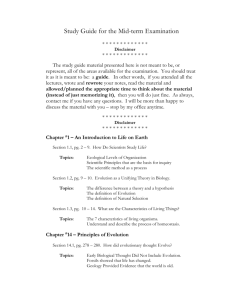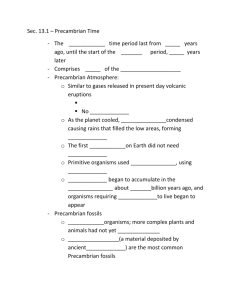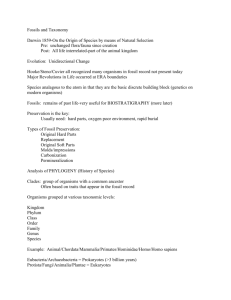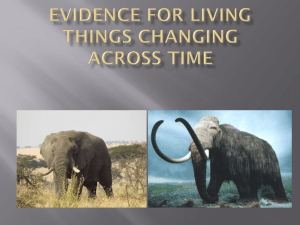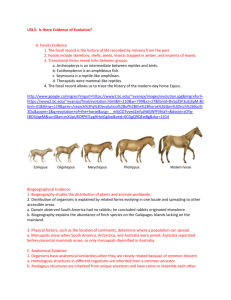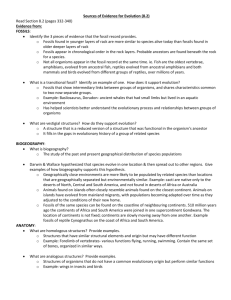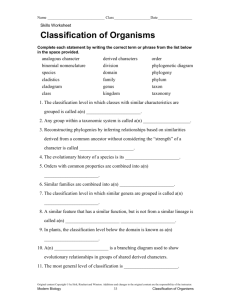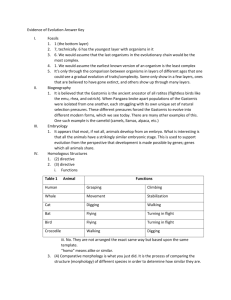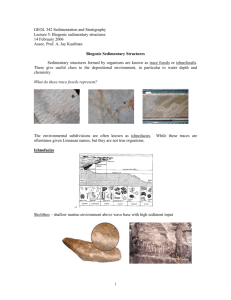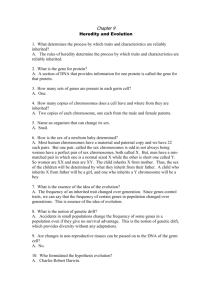Concept Check 15.1 - Plain Local Schools
advertisement
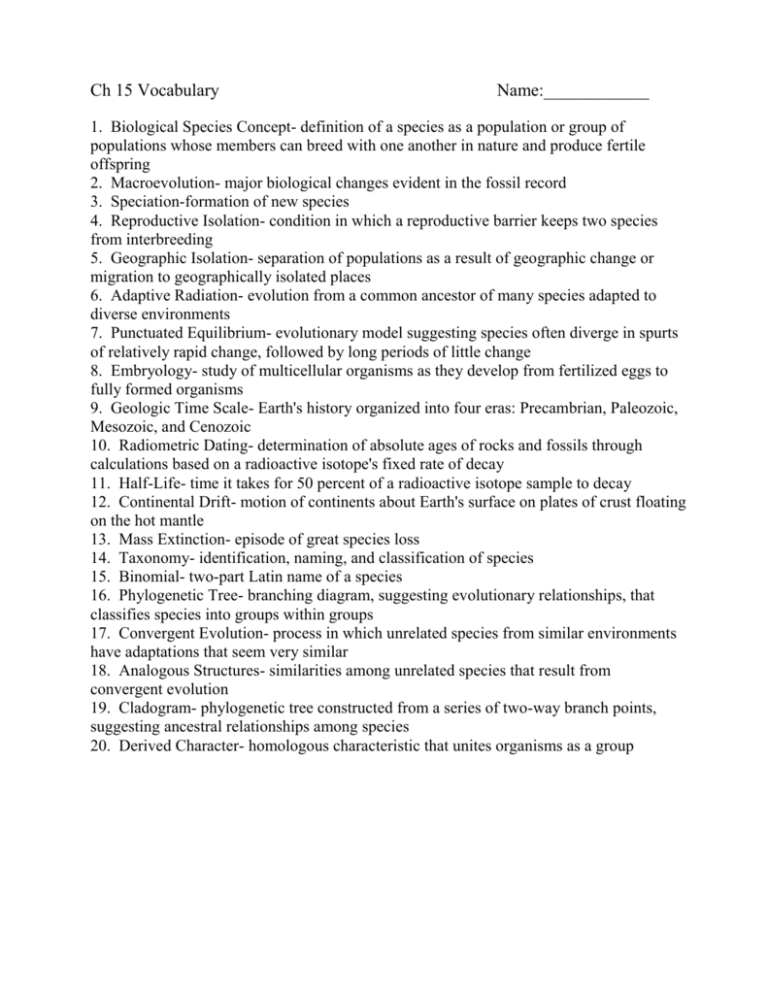
Ch 15 Vocabulary Name:____________ 1. Biological Species Concept- definition of a species as a population or group of populations whose members can breed with one another in nature and produce fertile offspring 2. Macroevolution- major biological changes evident in the fossil record 3. Speciation-formation of new species 4. Reproductive Isolation- condition in which a reproductive barrier keeps two species from interbreeding 5. Geographic Isolation- separation of populations as a result of geographic change or migration to geographically isolated places 6. Adaptive Radiation- evolution from a common ancestor of many species adapted to diverse environments 7. Punctuated Equilibrium- evolutionary model suggesting species often diverge in spurts of relatively rapid change, followed by long periods of little change 8. Embryology- study of multicellular organisms as they develop from fertilized eggs to fully formed organisms 9. Geologic Time Scale- Earth's history organized into four eras: Precambrian, Paleozoic, Mesozoic, and Cenozoic 10. Radiometric Dating- determination of absolute ages of rocks and fossils through calculations based on a radioactive isotope's fixed rate of decay 11. Half-Life- time it takes for 50 percent of a radioactive isotope sample to decay 12. Continental Drift- motion of continents about Earth's surface on plates of crust floating on the hot mantle 13. Mass Extinction- episode of great species loss 14. Taxonomy- identification, naming, and classification of species 15. Binomial- two-part Latin name of a species 16. Phylogenetic Tree- branching diagram, suggesting evolutionary relationships, that classifies species into groups within groups 17. Convergent Evolution- process in which unrelated species from similar environments have adaptations that seem very similar 18. Analogous Structures- similarities among unrelated species that result from convergent evolution 19. Cladogram- phylogenetic tree constructed from a series of two-way branch points, suggesting ancestral relationships among species 20. Derived Character- homologous characteristic that unites organisms as a group ANSWERS - Chapter 15: Origins of Biological Diversity Concept Check 15.1 1. Why are donkeys and horses considered different species? - Donkeys are infertile offspring of a horse and mule. 2. What is macroevolution? -Major evolution changes evident in fossils record; origin of new species, extinction of species, evolution of major new adaptations. 3. Give an example of a reproductive barrier that may separate two similar species. - Timing of, courting behavior, habitat, incompatible structures, zygotes fail to develop, infertile offspring 4. Describe conditions that could make a new island a likely place for adaptive radiation. - Have different habitats with varying environmental conditions; Organisms may adapt to varied conditions in different ways resulting in species diversity. 5. How does punctuated equilibrium relate to Darwin's theory of natural selection? - Natural selection and genetic drift cause most change as a new species. Major change is less common once a species is established. Concept Check 15.2 1. How can evolution explain the range of complexity of eyes in modern organisms? - Complex eyes could have evolved from modifying existing, simpler structures. Simpler eyes still exist in some modern species. 2. Give an example of evolutionary remodeling of an existing structure to a new function. - Exoskeleton protect land arthropods from drying out, modified wings enable penguins to swim 3. Identify one possible event during an organism's embryonic development that can result in a change in body form. - Mutations in the homeotic gene; change in rate or timing during development Concept Check 15.3 1. Which parts of organisms are most commonly found as fossils? -Hard parts such as shells, bones, and teeth 2. What main characteristic distinguishes the fossil record of the Paleozoic Era from that of the Precambrian Era? -Great diversity of multicellular animal fossils with hard parts 3. How are the relative ages of fossils in sedimentary rock determined? -Relative age is based on the position of rock layers. Longer ago the fossil was formed, the deeper the layer of fossils. 4. How does a mass extinction change conditions for species that survive? -Makes new opportunities for the survivors, making adaptive radiation possible. Concept Check 15.4 1. Give two reasons why common names of organisms can lead to confusion. -May describe more than one species, differ in areas of country or in languages 2. Why are analogous structures not useful for classifying species in an evolutionary context? - Analogous structures do not reflect evolutionary relationships 3. What does a branch point in a cladogram represent? - Branch point is an ancestor common to all organisms that extend from that branch point. 4. How does the three-domain model of classification differ from the five-kingdom model? - Three domain separates two groups of prokaryotes and one eukaryotes. In five kingdom model- bacteria and archaea are in one group called Monera.
